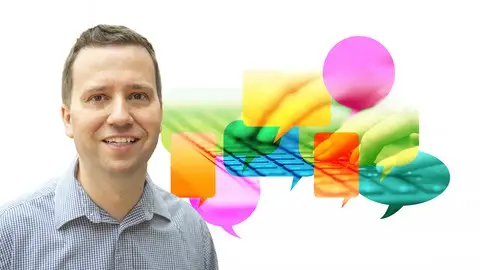Microsoft Applied Skills: Azure Ai Language
Last updated 3/2024
MP4 | Video: h264, 1920x1080 | Audio: AAC, 44.1 KHz
Language: English | Size: 1.22 GB | Duration: 3h 20m
Last updated 3/2024
MP4 | Video: h264, 1920x1080 | Audio: AAC, 44.1 KHz
Language: English | Size: 1.22 GB | Duration: 3h 20m
Use the portal, Python and C# to extract information, classify text, ask questions, and summarize text-Azure AI Language
What you'll learn
Deploy a language resource
Use prebuilt models
Create a custom text classification solution
Create a custom named entity recognition (NER) solution
Requirements
There are no requirements for watching the course.
We'll look at how you can get a free trial of Azure for use in this course.
If you want to use the code in this course, you will need a Windows machine or some Linux systems. You cannot currently use this code on MacOS, Android or iOS devices. However, you can watch the videos in this course on these devices.
Description
Microsoft Azure allows you to extract information from your text. Among other things, you can classify and summarize text, and ask it questions.In this 3 hour course we’ll cover the skills that you need for the Microsoft Applied Skills credential for building a natural language processing solution with Azure AI Language.It will also help with the Microsoft exam AI-102 "Designing and Implementing a Microsoft Azure AI Solution".First, we’ll sign up for a free Azure subscription. Then, we’ll create a Language resource, and use it to analyze text. We’ll use the pre-built models to detect the language, extract key phrases, recognise entities and sentiment, and more.After that, we’ll analyze the text using Python and C#. We connect to the Language resource and analyse text, extracting the information for use in our own programmes.Finally, we’ll create our own custom models for text classification and named entity recognition extraction. We’ll upload documents into an Azure Storage Account container, train the model based on labels, and test it using the portal, Python and C#.There are several practice activities and quizzes throughout the course, so you can be sure that you are learning.By the end of the course, you'll be able to analyse your own text in the portal and using Python and C#, and perhaps even take the official Microsoft assessment. That would look great on your CV or resume.
Overview
Section 1: Introduction
Lecture 1 Introduction
Lecture 2 Welcome to Udemy
Lecture 3 How to get the best out of your Udemy course
Lecture 4 Do you want auto-translated subtitles in more languages?
Lecture 5 Curriculum
Lecture 6 Resources
Section 2: Installing Azure AI Language, and detecting Language
Lecture 7 Creating an Azure account, and exploring Azure interface
Lecture 8 Creating an Azure AI Language resource
Lecture 9 Exploring the Language Studio and Detecting Language
Lecture 10 Installing Visual Studio Code and copying connection details
Lecture 11 Detecting Language using Python
Lecture 12 Detecting Language using C#
Lecture 13 Practice Activity Number 1
Lecture 14 Practice Activity Number 1 - The Solution
Section 3: Other prebuilt models - Part 1
Lecture 15 Understand questions and conversational language
Lecture 16 Summarising conversations
Lecture 17 Extracting Key Phrases
Lecture 18 Using Key Phrases in our Python code, and creating an environment file
Lecture 19 Using Key Phrases in our C# code
Lecture 20 Named Entity Recognition (NER) - prebuilt
Lecture 21 Using NER in our Python code
Lecture 22 Using NER in our C# code
Section 4: Other prebuilt models - Part 2
Lecture 23 Personally Identifiable Information (PII) detection
Lecture 24 Using PII in our Python code, and adding a condition
Lecture 25 Using PII in our C# code, and adding a condition
Lecture 26 Entity linking
Lecture 27 Using Entity linking in our Python code
Lecture 28 Using Entity linking in our C# code
Lecture 29 Sentiment analysis and opinion mining
Lecture 30 Using Sentiment analysis and opinion mining in our Python code
Lecture 31 Using Sentiment analysis and opinion mining in our C# code
Section 5: Custom text classification
Lecture 32 Uploading documents and creating a new text classification project
Lecture 33 Labelling Documents and Creating a Training Job
Lecture 34 Investigating Model Performance, Deploying a Model, and Testing the Deployment
Lecture 35 Using Custom text classification in our Python code
Lecture 36 Using Custom text classification in our C# code
Lecture 37 Practice Activity Number 2
Lecture 38 Practice Activity Number 2 - The Solution
Section 6: Custom NER
Lecture 39 Uploading documents and labelling documents in a custom NER
Lecture 40 Training, assessing model performance, deploying a model and testing deployment
Lecture 41 Using Custom NER in our Python code, and adding comments
Lecture 42 Using Custom NER in our C# code, and adding comments
Lecture 43 Practice Activity Number 3
Lecture 44 Practice Activity Number 3 - The Solution
Section 7: Congratulations for completing the course
Lecture 45 Other custom capabilities and Deleting Azure resources
Lecture 46 What's Next?
Lecture 47 Congratulations for completing the course
This is for you if you want extract key phrases, linked or named entities, PII (personally identifiable information), classify text, including analyzing sentiment, answer questions and summarize text.,This course will guide you through the skills required for the Microsoft Applied Skills credential "Build a natural language processing solution with Azure AI Language".



